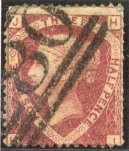 |
 |
1840 - 1879 Line-Engraved Imperforate Issues
One Penny Black, Type A1, Imperforate, Die I, Plate 1a.
Re-entry flaw under "B". First Issued 15 April 1840.
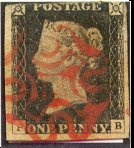
Very Fine Used Condition.
Plate 1 of the 1d. Black was registered on 15 April 1840. As the plate had not been hardened, it soon showed signs of wear.
A second sheet is recorded as having been registered on 27 April
1840. This plate was later withdrawn and extensive repairs were undertaken. It is usual to refer to the plate as "Plate 1a"
and to the repaired state as "Plate 1b"
Red Maltese Cross
Cancellation. These cancellation handstamps were officially issued for use with the first postage stamps and the Mulready in May 1840.
They were made individually and by hand so that no two are alike. A red ink was
first employed, but was superceeded by black in February 1841.
Plate 23.
One Penny Red, Type A1, Imperforate, Die I Alphabet I,
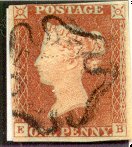
Very Fine Used Condition.
Regestered in January 18 1842 and destroyed 21 February 1843. Triple north-east breaks appear throughout the plate.
This example displays these flaws, which can be readily seen on the top right of the
stamp.
The 1d. red plates from Plate 12 to Plate 36 are usually not difficult to plate from single stamps for a number of reasons.
Used copies are usually cancelled with a Maltese Cross.
Most of these stamps fall into separate categories by reason of frame-line flaws or ray flaws.
Black Maltese Cross Cancellation. It is now known that due to delays in the delivery
of paper and difficulties experienced over the gumming, the first supply of the 2d. value for sale to the public was delivered to the
London Inland Revenue Office on the afternoon of 8 May 1840. The first 2d. stamp,
of which there were two plates, differs from all subsequent 2d. issues in having no white lines above the value and below "POSTAGE".
It is often termed "the 2d. no lines". The special new type of ink, first employed
for the Penny Red printings from Plate 1, was used for the twopence from Plate 3 onwards. The Twopence Plate 3 was finished on 25
February 1841, and printing from it commenced two days later. The stamps were printed on
Small Crown watermarked paper which often showed Fine used considerable bluing. All sheets from this plate were condition, issued i
mperforate. The earliest known used example is 17 March 1841. The plate was in use until
December 1849, a period of nearly nine years, during which time 191000 sheets were printed.
Two Penny Blue, Type El, Imperforate, Die I Alphabet I, Plate 3.
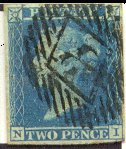
Fine Used Condition.
This issue was contemporary with the 1 d. black and therefore shares the distinction
of being one of the worid's first two postage stamps. The die for the
first 2d. stamps were taken indirectly from the Original Die of the One Penny so that the details of the designer, printer, etc., are
all as with the Id. black issue.
One Penny Red, Type Al, Officially Perforated
After trials, machines giving a gauge 16 perforation were brought into use on 28 January 1854. The earliest officially perforated stamps came from plates, which were already in use and from which imperforate sheets had already emanated. The first and second issues used Die I and Alphabet II and were on blued paper with a small crown watermark. The next major issues used Die Il and Alphabet II with small or large crown watermark also on a blued paper. The blued colour of the paper was due to the use of prussiate of potash as a method of fixing the ink to the paper.
In an attempt to remove the blue colour from the paper, there were a number of experiments carried out in 1856. These experiments were only partially successful and produced many stamps with blotched areas of blue still remaining. The first stamps completely free of bluing are known as the ``transitional" shades. This may have been due to the use of old inks which did not contain prussiate of potash or standard inks that contained a neutralising agent. A neutralising agent is most likely due to the cream-toning which is typical of paper used at the time
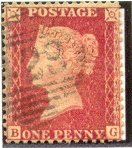 |
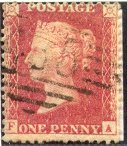 |
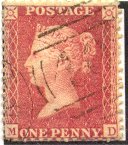 |
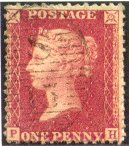 |
The last group consists of stamps that ware printed on white paper, including the distinctive red-brown shade on yellowish to cream paper which was In use between November 1856 and February 1857. | |||
| 1856-63, Die II alphabet III, White Cream Paper, Watermark Large Crown, Type I, Perf 14, Red-Brown |
1856-63, Die II alphabet III, White Cream Paper, Watermark Large Crown, Type I, Perf 14, Red-Brown |
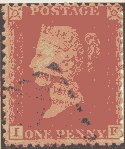 |
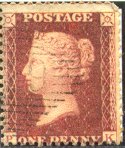 |
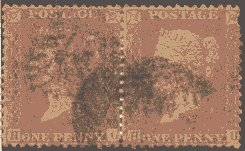 |
1856-63, Die II alphabet III, White Cream Paper, Watermark Large Crown, Type I, Perf 14, Red-Brown |
The paper was made by Stacey Wise of Rush Mills and, being handmade, varied a good deal in thickness. The sheets were Issued with ragged or ``deckle" edges on
all sides. The gum was made of potato starch, variable in colour, efficiency and taste. After 1855 some gelatines was added and in 1884 double-gumming was adopted. Gum was always applied after the sheets were printed.
The inks used for the 1d. and 2d. during the first year of issue were not fugitive and numerous cases of stamps being cleaned and re-used came to the notice of the Post Office. Accordingly in 1841 the � d. colour
was changed to red-brown (commonly called ``red') and the ink was made fugitive by the addition of prussiate of potash. The 2d. was not changed In colour as a fugitive blue was available but white lines were added to the design of
this value to allow Identification of the stamps printed In the new ink. The original paper was greyish white but as a result of chemical action between the paper and the fugitive inks introduced in 1841, a bluish
discoloration was usual. In 1857 the bluing was eliminated. Double fugitive ink was first used on the Id. Lilac of 1881. The watermark ``bits" were affixed to the wire gauze of the paper mould. The Small Crown bits
were hand shaped of fine brass wire, consequently small differences of shape and size are found. The Large Crown bits were stamped out of sheet brass and show no variation other than errors.
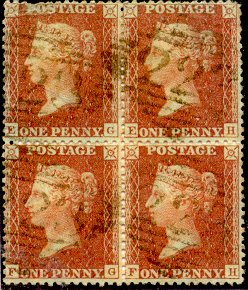 |
|
Line Engraved Stamps with Letters in all Four Corners and with Plate Numbers incorporated in the Design
The stamps with letters in all Four Corners have the same letters at the top as at the bottom but in reverse order. In identifying these stamps the bottom
letters are always quoted.
The plate numbering of this issue begins at plate 71 and ends at plate 225 with some plate numbers not being used.
Sheets consisted of 240 stamps.
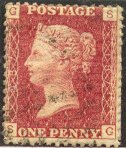 |
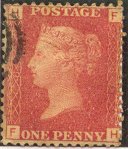 |
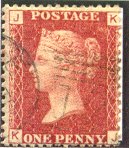 |
Plate 187 |
Plate 87 |
Plate 112 |
These 2d. stamps were the companion to the 1d. of similar form.
The fact that the 2d. preceded the 1d. by some six years was solely the result of delays in
the production of the 1d. plates. The 2d. die was produced by the modification of an impression taken from the 1d.
Die II. There were two impressions taken from the new 2d. die, the first having thick lines below
POSTAGE and TWOPENCE then the second.
Two Penny, Type G2. 1858(July). With Thick White Lines. Watermark Large Crown. Perf 14.
These 2d. stamps were the companion to the 1d. of similar form.
The fact that the 2d. preceded the 1d. by some six years was solely the result of delays in
the production of the 1d. plates. The 2d. die was produced by the modification of an impression taken from the 1d.
Die II. There were two impressions taken from the new 2d. die, the first having thick lines below
POSTAGE and TWOPENCE then the second.
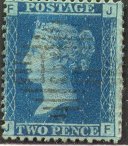

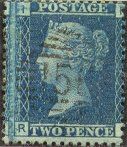
Halfpenny, Type G3. 1870 (1 October). First Halfpenny Stamp. Watermark W3. Perf 14
The sheets of the 1/2d. were of 480 stamps in 20 rows of 24.
The lettering (of the lower corners) ran from AA to AX in the top row and so onto the bottom row,
TA to TX. The top corners of the stamps merely repeated the lettering of the lower corners. The top
corners of the stamps repeated the lettering of the lower corners, in reverse. The watermark ``halfpenny", Type 3, extended over
three stamps. Stamps imperforate on the right or left side from A to X vertical rows occurred owing to a
custom adopted methof of leaving one of the edges imperforate. "``o Watermark""are known, doe to the faulty
registration or badly cut paper. Valid plates used were in the range 1 to 20.
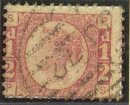
Three Halfpence, Type G4. First Three Halfpence Stamp. Wink Large Crown, Type II, Pert 14.
In 1860 a 1 1/2d. stamp which was rosy mauve
was printed but not issued. This preparation was made of a rise in postal rates, which did not happen. Although
10,000 sheets were printed, in 1867, 8.962 sheets were distroyed and only a few survive in unused confition.
During 1870, Plate 1 was used again, this time in the issued rose-red colour. This plate did not have the
plate number incorporated in the design. Plate 2 was defective and was not completed, so, no stamps exist from it.
Plate 1 was put to press for a second time in the issued colour on 6 June 1870. Plate 3 was
resistered ib 13 April 1874 and put to press on 10 August 1874.
